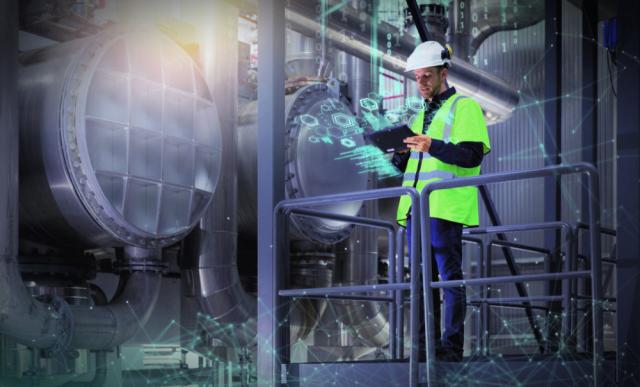
The oil and gas industry has a critical role to play in the success of the global energy transition. However, it has become clear that old ways of working—despite having been successful in the past—will have to change dramatically, writes Jennifer Hooper, senior vice president of industrial applications process solutions for Siemens Energy. (Source: Siemens Energy)
The oil and gas industry looks vastly different than it did just two years ago. From digital transformation to decarbonization, companies across the value chain are reevaluating how they do business.
There is no question that the pace of the energy transition has accelerated; perhaps much faster than many expected. This, along with the global pandemic, has presented complex challenges for the industry, but they are by no means insurmountable.
On the operational side, companies from upstream to downstream are making tremendous progress in reducing emissions by applying new technologies and methods. Innovation will undoubtedly continue and be a key driver on the journey to a low-carbon future.
While the human element of the transition is often given less attention, it is equally as important. To this end, organizations must begin to think differently about how they approach workforce development and how they engage with their partners and customers. After all, it is people and ideas that are the true catalysts for change.
Embracing diversity
The oil and gas industry has historically taken a conservative approach to workforce development in that it has preferred to look within to find new talent. This is true not only in terms of technical skills related to engineering and operations but also in the case of leadership roles.
However, the challenges organizations faced in the past are not the same ones they face today. Nor are they the same challenges they will encounter in the future. With the industry on the precipice of a transformation, the need to embrace ideas from outside the sector is perhaps more significant than ever.
Diversity is essential in this regard, as it contributes to the diversity of perspectives on how best to address pressing issues like decarbonization. It also facilitates new ways of working, which will be critical as industrial verticals increasingly converge.
Collectively, the industry must be mindful and purposeful that it is not becoming stagnant by copying yesterday's playbook. Executives and decision-makers in particular must remain curious learners and acknowledge the reality that while we do not yet have all the answers, any challenges can and will be overcome so long as we keep an open mind.
Powerful partnerships
Successfully navigating the energy transition will also require companies to embrace new types of partnerships.
There is no single organization or entity that has the resources or technologies to combat the effects of climate change on its own. True energy transformation will require co-creation and collaboration from many different stakeholders, including those from both the public and private sectors.
This is a mindset that Siemens Energy, along with many other companies across the industry, is putting into practice. One specific example is the recent partnership with Odfjell Oceanwind.
Together with Siemens Gamesa, Siemens Energy and Odfjell Oceanwind are developing mobile offshore wind units (MOWUs), which will be used as part of Odfjell Oceanwind’s WindGrid hybrid system. WindGrid leverages energy storage and grid converters to create offshore “microgrids” designed to supply uninterruptible, emissions-free power to off-grid oil and gas facilities that traditionally relied on fossil fuel-based power generation from gas turbines or diesel generator sets. This includes both drilling rigs and production installations.
Siemens Energy is providing the energy storage solution, AC power grids, transformers, switchboards, and power control system for the MOWUs, while Siemens Gamesa will supply the wind turbines.
Another example is the collaborative partnership between Siemens Energy and Swedish-based Liquid Wind AB.
Liquid Wind is a clean energy leader that aims to accelerate carbon-neutral transportation by bringing renewable methanol (i.e., eMethanol) to market at scale. Siemens Energy is providing an equity investment to Liquid Wind AB and will contribute technology and expertise to developing eMethanol facilities.
The first of Liquid Wind’s facilities will integrate a 70-megawatt PEM-Electrolyzer from Siemens Energy, which will use renewable electricity to split water into green hydrogen and oxygen. The green hydrogen will be combined with biogenic CO₂ to form carbon-neutral methanol.
As a fuel for mobility applications and feedstock for the chemical industry, green methanol can decisively drive the de-fossilization of industry sectors. At the same time, integrating methanol production into existing industrial facilities, such as combined heat and power plants or pulp and paper mills, creates a local and CO₂-neutral closed-loop system.
In the case of Liquid Wind, the methanol will replace hydrocarbon-based fuels in shipping applications, preventing emissions of an estimated 100,000 tons of CO₂ every year.
These examples demonstrate what is possible when companies (who might not have typically considered engaging in the past) bring to the table the full breadth of their technologies and capabilities to serve a common cause.
The road ahead
The success of the global energy transition hinges on mitigating climate change and striking a balance between affordable and reliable energy. The oil and gas industry has a critical role to play on this journey. However, it has become clear that old ways of working—despite having been successful in the past—will have to change dramatically.
For organizations to thrive in the new environment, an open and inclusive culture that promotes innovation and new ideas is a must—no matter how foreign or unconventional they may seem. With the only certainty being that the future will look different from the past, businesses' ability to remain agile and think “outside the box” will be a significant competitive advantage.
Jennifer Hooper serves as senior vice president of industrial applications process solutions for Siemens Energy.
Recommended Reading
Texas LNG Export Plant Signs Additional Offtake Deal With EQT
2024-04-23 - Glenfarne Group LLC's proposed Texas LNG export plant in Brownsville has signed an additional tolling agreement with EQT Corp. to provide natural gas liquefaction services of an additional 1.5 mtpa over 20 years.
US Refiners to Face Tighter Heavy Spreads this Summer TPH
2024-04-22 - Tudor, Pickering, Holt and Co. (TPH) expects fairly tight heavy crude discounts in the U.S. this summer and beyond owing to lower imports of Canadian, Mexican and Venezuelan crudes.
What's Affecting Oil Prices This Week? (April 22, 2024)
2024-04-22 - Stratas Advisors predict that despite geopolitical tensions, the oil supply will not be disrupted, even with the U.S. House of Representatives inserting sanctions on Iran’s oil exports.
Association: Monthly Texas Upstream Jobs Show Most Growth in Decade
2024-04-22 - Since the COVID-19 pandemic, the oil and gas industry has added 39,500 upstream jobs in Texas, with take home pay averaging $124,000 in 2023.
What's Affecting Oil Prices This Week? (Feb. 5, 2024)
2024-02-05 - Stratas Advisors says the U.S.’ response (so far) to the recent attack on U.S. troops has been measured without direct confrontation of Iran, which reduces the possibility of oil flows being disrupted.




